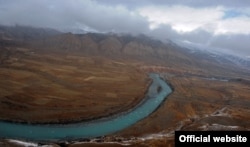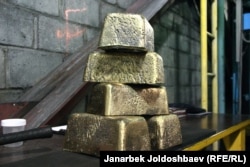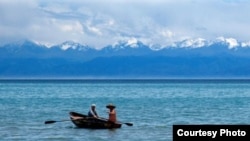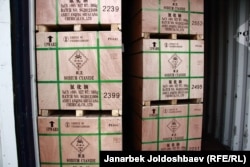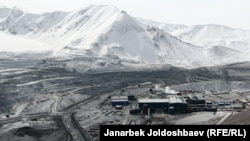
More than 22 years after a deadly cyanide spill contaminated a remote mountain river of Kyrgyzstan, a Bishkek court has ruled in the case of more than two dozen residents of the northeastern village of Barskoon thought to have been poisoned by a transport accident near the Canadian-Kyrgyz gold-mining operation.
The court ordered on August 10 that the surviving plaintiffs each receive 400,000 soms (about $5,700) for being poisoned after the 1998 accident on a road leading to the Kumtor gold mine, which dumped nearly a ton of cyanide into the river that runs through their village.
The plaintiffs plan to appeal the ruling despite their notable lack of success in more than two decades of trying -- with time running out.
No Cause For Alarm?
On May 20, 1998, a truck from the jointly owned Kumtor gold-mining company carrying sodium cyanide used in cleaning gold overturned on the road and rolled into the river above the village of Barskoon, spilling some 1.7 tons of sodium cyanide (around 935 kilograms of cyanide).
The mine lies in what the environmental watchdog BankWatch described as "fragile conditions of permafrost and in the vicinity of glaciers that feed fresh waters into the transboundary Naryn River."
The company failed to notify Barskoon's 6,500 or so residents, who use the river water for drinking and irrigation, for around five hours after the incident.
Once authorities announced the accident, they warned residents in the area against drinking from the river -- the village's sole source of potable water -- but assured them that there was no cause for alarm.
It was not long before people started falling ill. Within a week, more than 500 people in the area had sought medical treatment; by June 9, that number had risen to nearly 5,000.
Within around two weeks of the spill, more than half the villagers in Barskoon had been evacuated. More would follow, from Barskoon and neighboring villages, until the entire area was essentially emptied of its residents.
At least several people died. Pregnant women reported being advised -- and in some cases forced -- to seek abortions.
Almost immediately, there were demands around the country that Kumtor's operator, Canada's Cameco Corporation (now called Centerra), be penalized and pay compensation. Some Kyrgyz called for the company to be expelled from the country.
BankWatch alleges that while Centerra "has been the client of the EBRD [multilateral bank] since 1995...the bank has failed to ensure that its client respects public social environmental concerns and social needs."
But still, things weren't so simple.
Kumtor Country
Cameco signed a deal with the Kyrgyz state gold company Kyrgyzaltyn in 1992, and they jointly produced their first gold in 1996.
In 1997, the Kumtor project's first full year of production, Kyrgyzstan's total gold output was some 17 tons of gold, 14 tons of which came from Kumtor. The gold-mining jump-started Kyrgyzstan's industrial output in 1997 and significantly helped the country cut its trade deficit.
By August 2019, the head of the macroeconomic policy department at the Kyrgyz Economy Ministry, Nasridin Shamshiev, said production at Kumtor accounted for more than 18 percent of national gross domestic product and nearly 45 percent of Kyrgyzstan's industrial output the previous year.
Kumtor was already important in 1998 and the decades that followed. But it is perhaps more important than ever in 2020, with Kyrgyzstan's industrial output generally forecast for a sharp drop due the coronavirus.
Immediately after the spill in 1998, a group of independent ecological experts headed toward Barskoon to inspect it, only to be prevented by the mine's operators from accessing the area.
On June 3, a Barskoon woman who had been taken to a hospital in the nearby town of Karakol died, in what appeared to have been the first death attributable to the accident.
The same day, Michel Bernard, who was Cameco's president at the time, said the spill posed no serious threat to residents or to nearby Issyk-Kul, the pristine alpine lake into which the Barskoon River flows.
Cameco pledged to clean up the spill and pay compensation to those who were affected by the cyanide that had contaminated the river.
The Kyrgyz government vowed improvements in Barskoon, for example by piping running water to the village.
By the middle of June, less than a month after the spill, the residents of the Barskoon area were told they could return to their homes.
The Barskoon That I Knew
Barskoon lies near the south shore of Issyk-Kul, the massive lake in northeastern Kyrgyzstan that is the country's premier tourist attraction. The north shore hosts most of the tourist areas, which in the 1990s were even more modest than what exists there today.
The second-largest mountain lake in the world, Issyk-Kul is nearly 180 kilometers east-to-west and a bit more than 50 kilometers north-to-south.
There is a ring road around the lake from which a steep, windy road leads up some 2,000 meters of elevation to the gold-mining site at Kumtor around 4,000 meters above sea level, passing Barskoon along the way.
Barskoon was a nice place to live. I know because I spent weeks there in the winter of 1992 and again in the spring of 1993 (which is why I also know that the most famous former resident of Barskoon, once called Barsgan, was Mahmud al-Kashgari, an 11th-century scholar who wrote the first comprehensive dictionary of Turkic languages).
My friendships with the people of Barskoon were why I was following events in the area closely after the accident.
I finally returned there in the late summer of 1998 to see how the people who had so kindly taken me into their homes and fed me were faring.
Barskoon's villagers had been promised compensation. When I arrived at the end of August, they told me that village children had each received some candy and five new pencils. That had been the compensation, they said, up to that point.
There were promises: a new school, a new medical facility, repairs to the road. But there was no indication that any of that would be realized anytime soon.
The locals said European-looking men in uniforms -- presumably employees of the mining company -- had initially sealed off their village, not Kyrgyz police or soldiers.
Cameco eventually agreed to a settlement of $4.6 million, but it is unclear that any of that money ever made it to Barskoon.
In 2005, Tursunbek Akun, the head of the human rights commission under then-President Kurmanbek Bakiev, told RFE/RL that most of the funds had simply vanished.
And the contamination was doing more than just sickening and killing Barskoon's people, they said; it also temporarily robbed them of one of their main sources of income, the export of locally grown apples.
Barskoon's apples had been known for their quality and sweetness. But after the spill, the villagers told me, no one would buy them. Some locals had even tried taking their apples to southern Kyrgyzstan for sale, but their documents were checked and they were told to take their suspect fruit back home.
Since then, locals have tried unsuccessfully several times to force the company to pay compensation.
Over the course of the past 15 years, the case has made it to Kyrgyzstan's Supreme Court four times. Each time, it has been returned to a lower court for review.
Local rights defender Erkingul Imankozhoeva has been trying to help the villagers to finally receive fair compensation, frequently crippled by a lack of documentation and other obstacles.
Imankozhoeva told RFE/RL's Kyrgyz Service, known locally as Azattyk, that despite thousands of cases of illness from the spill, Kyrgyz courts only allowed individuals with medical documentation specifically linking their afflictions to the cyanide discharge to sue Kumtor for compensation.
In 2005, Jypar Jeksheev, who was the Barskoon region's representative in parliament when the accident happened, told Azattyk that the medical records of many of those who fell ill after the spill had subsequently been altered to suggest outside causes of medical problems, freeing the government and the Canadian company of responsibility.
When the lawsuit was first filed, there were only 29 locals in possession of the necessary medical records. Twelve of them have since died.
One of the plaintiffs in the case, Mirgul Urmanbetov, said he felt 400,000 som was meager compensation, considering what the contamination's victims had been through.
"We have little hope that justice will prevail," he added. "We are afraid that the process will again drag on until the statute of limitations expires, and then they will close [the case]."
According to the Centerra website, the Kumtor gold mine produced 12.6 million ounces of gold between 1997 and the end of 2019.
Epilogue
Kyrgyz President Askar Akaev visited the Czech Republic in November 1998.
As an RFE/RL correspondent, I went to an accompanying press conference at Prague Castle.
Akaev looked pleased next to Czech President Vaclav Havel. People had compared Akaev, with his academic rather than political background, to Prague's famous dissident writer-cum-president. In the early 1990s, some people had even labeled Akaev "the Vaclav Havel of Central Asia."
I was allowed to ask one of the three questions that were permitted at the press conference.
Most of the journalists were there to hear from Havel, and the first two questions had been for him.
Then it was my turn. I introduced myself and said what organization I worked for and, in Russian, welcomed Akaev to the Czech Republic before asking my question.
"I was just in Barskoon," I said, "and the people there told me they were promised compensation but all they received was some candy and pencils. Does the Kyrgyz government plan to do something to help the people of Barskoon?"
The smile vanished from Akaev's face and he looked at me and replied, "It is not only Radio Liberty that is concerned for the people in Barskoon."
But despite whatever concern Akaev was alluding to, neither his (he was ousted in the 2005 Tulip Revolution) nor any other Kyrgyz government appear to have been trying very hard to compensate the people of Barskoon.




